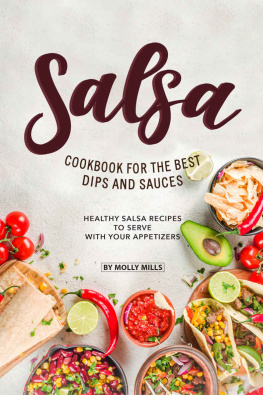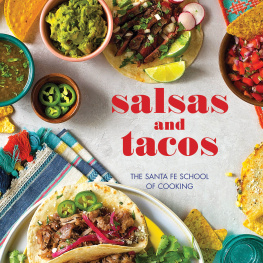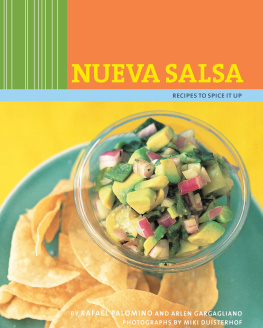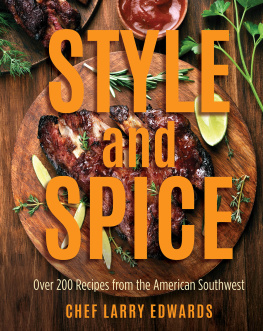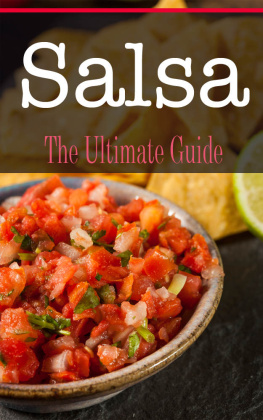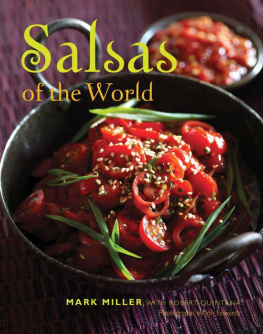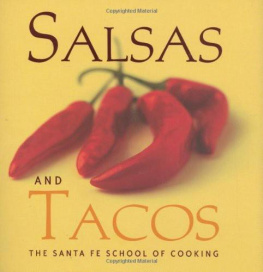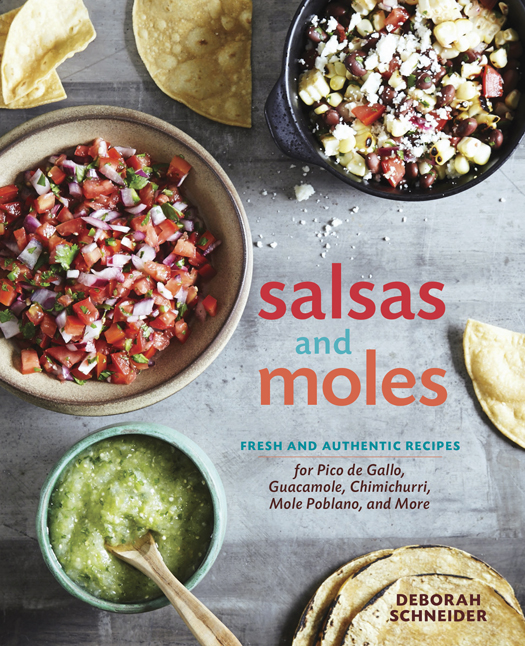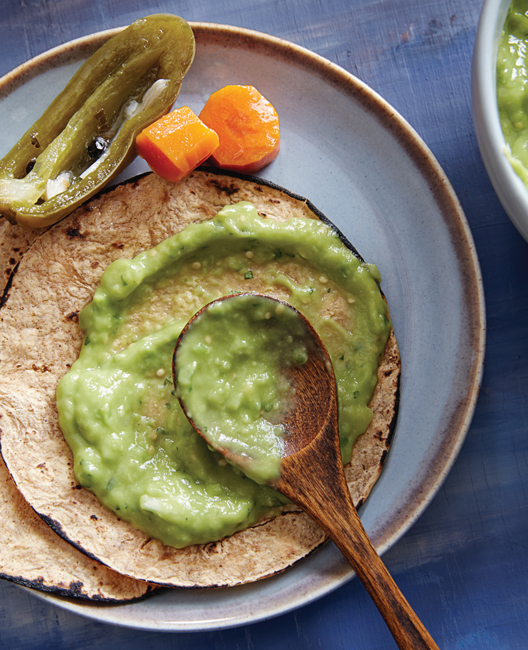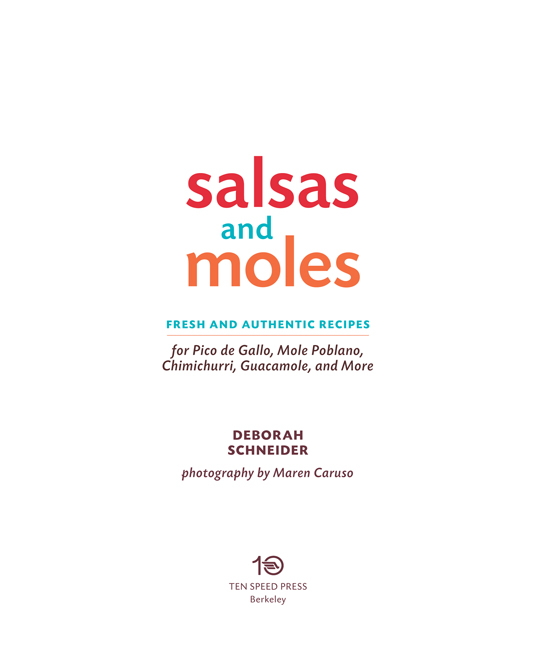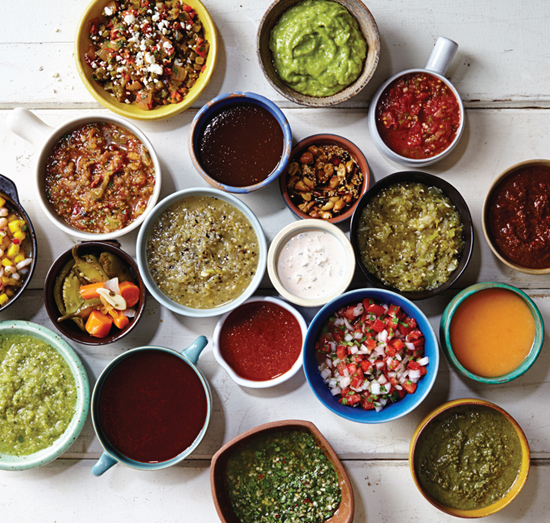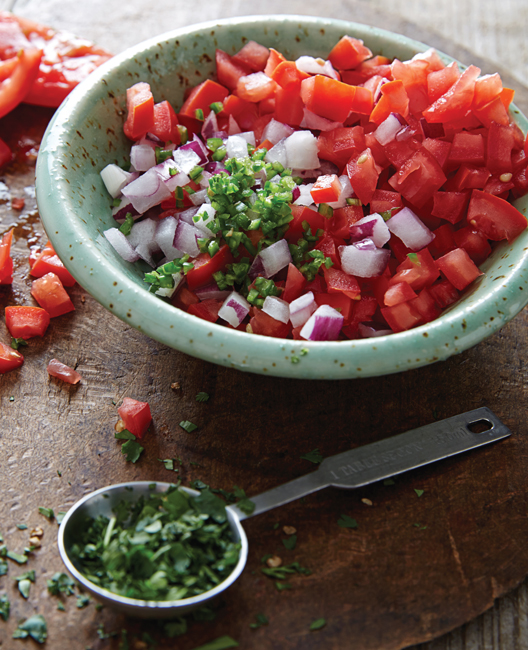Copyright 2015 by Deborah Schneider
Photographs copyright 2015 by Maren Caruso
All rights reserved.
Published in the United States by Ten Speed Press, an imprint of the Crown Publishing Group, a division of Random House LLC, a Penguin Random House Company, New York.
www.crownpublishing.com
www.tenspeed.com
Ten Speed Press and the Ten Speed Press colophon are registered trademarks of Random House LLC.
Library of Congress Cataloging-in-Publication Data
Schneider, Deborah M.
Salsas and moles : fresh and authentic recipes for pico de gallo, mole poblano, chimichurri, guacamole, and more / Deborah Schneider ; photography by Maren Caruso.First edition.
pages cm
Includes index.
1. Salsas (Cooking) 2. Sauces. 3. Cooking, Mexican. I. Title.
TX819.S29S374 2015
641.814--dc23
Hardcover ISBN: 978-1-60774-685-0
eBook ISBN: 978-1-60774-686-7
Design by Kara Plikaitis
Food Styling by Robyn Valarik
v3.1
To Barry, Will, and Annie, your love is the broth
in which the dumpling of my life floats,
and your pungent (and very funny) observations
season all my days.
contents
acknowledgments
I HAD SUCH A BLAST WRITING THIS BOOK!
I am extremely grateful to Ten Speed Press for the opportunity to bring this collection of stellar salsas to my tribe of cooks, bedside chef-readers (you know who you are), and food wonks. Thanks to the group of talented individuals who made a wonderful book: my so-patient editor Kelly Snowden; editor emeritus Melissa Moore, whose idea this book was; book design artista Kara Plikaitis; and publicist Erin Welke. Photographer Maren Carusos amazing aesthetic highlights the beauty of this simple food, aided by stylist Robyn Valarik. And as usual, my dear friend and super-agent Carole Bidnick rode in on her white horse to make it all happen.
In the case of anything food-related, it takes a villagearmed with tasting spoonsto make it all come together. To all my customers at SOL Mexican Cocina and Solita Tacos & Margaritas, my heartfelt gratitude for your support and feedback over the years. I learn from you! To my partners Matt Baumayr, Rich Howland, and the Mastro family, thank you for letting me follow my vision, even if it did have to expand to include a burrito.
All cooks build on the expertise of those who went before us. I want to thank all the cooks who answered my questions or let me watch them cook and gener-ously shared their skill and knowledge. You taught me so much and set me on this road. To Benito Mirafuentes, Joe Saldana, and Manny Lopez; Chefs Octavio Flores, Ernesto Lopez, and their cooking crews at SOL and Solita; Danny Esparza, Francisco Arenas, and so many others: all of you patiently and graciously shared your memories of Mexico and decades of experience with me. Love you guys! I am eternally, profoundly grateful for the access to Mexicos culinary soul so generously shared by Ruth Alegria, Patricia Quintana, and Chef Gerardo Lugo of Mexico Citys Restaurante Nicos. And of course, to Toni Allegra, who started it all.
Abrazos!
introduction
A GREAT SALSA MAKES A
BIG IMPRESSION WITH
A LITTLE BITE
In some form, salsas will be part of every bite you eat in Mexico. They are the highest culinary expression of a creative culture and carry a kind of cult status, because every Mexican cook (and street stand) has a special, secret salsa recipe.
Salsas are always as important as entres or side dishes and have specific uses: simple table, or casera, salsas are used to add last-minute flavor and juiciness to food. Hot salsas always make an appearance, because Mexican cooking is almost never spicy in and of itselfyou get to add heat to your own taste, al gusto . Chunky raw fruit and vegetable salsas are so colorful and full of flavor that they can stand alone as botanas (snacks). Dried chiles and fresh chiles are transformed into salsas of incomparable flavor, often used as the savory base for soups and stews, such as carne con chile colorado . At the very peak of sophistication is molein appearance just a salsa, but in taste, embodying the culinary history of Mexico.
Salsa in Mexico represents more than just something to eat, though. Salsa is the heart of the cuisine. Because I am such a silly romantic about food, salsas seem to me to hold the story of Mexicohistory in a bite. As my friend Ruth Alegria says, you get Mexican food when you get salsawhen you understand its role and its importance to the cuisine. You get a sense of Mexico, too: this gorgeous, vivid hybrid of medieval Spain and thousands of years of native American cultures.
Mexicos cuisine is far more complex and imaginative than that of its closest neighbors. It begins with geography. The country encompasses multiple climate zones from north to south, from snow-capped mountains to searing desert to tropical jungle; from east to west it traverses infinite microclimates, climbing from sea to mountains and descending to sea againa fertile matrix for botanical and culinary diversity. Further boosting its diverse influences, Mexico has been a crossroads of ancient trade paths from North America to South America for thousands of years. Canoe traders of the Caribbean and Pacific coastlines brought ingredients and ideas to already sophisticated indigenous cultures in the central highlands and along the coasts; the Spanish brought meat, dairy, wheat, and exotic Eastern spices.
Mexico is revolutionary, imaginative, colorful, wildly varied, and hyperregional, though lines have blurred so that different regions, once remote, have flowed into each other, and some previously regional salsas are familiar throughout the country. But still, in the Maya country, you get Mayan salsas and flavors that exactly complement their unique tropical cooking; in Chihuahua, you taste desert heat and flint in salsas made of spicy dried chiles, tailor-made for the vaquero cooking of meat, beans, and cheese. In Veracruz, salsas reflect the hot face of the Caribbean sun and are exactly right for the languid lifestyle and fresh seafood cooking of this region. You always know where you are in Mexico by the salsas set before you. No other country infuses so much variety and flavor into its everyday cooking.
The expectations we have in the United States for what salsa is supposed to be and do are very different than in Mexico. In Mexico, one or maybe two salsas might be offered, and their function is simple and precise: add a bit of expected flavor, add some moisture, maybe add some heat to whats in front of you. You will always see the same kinds of salsa used in the same waytraditional salsas are always served with their time-honored partners. Of course, those traditional Mexican combinations of flavors are perfect: nothing is better with carnitas than salsa verde and onions!



